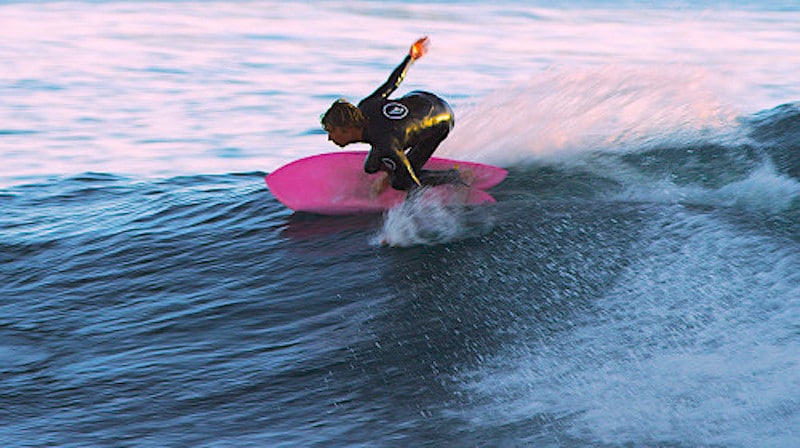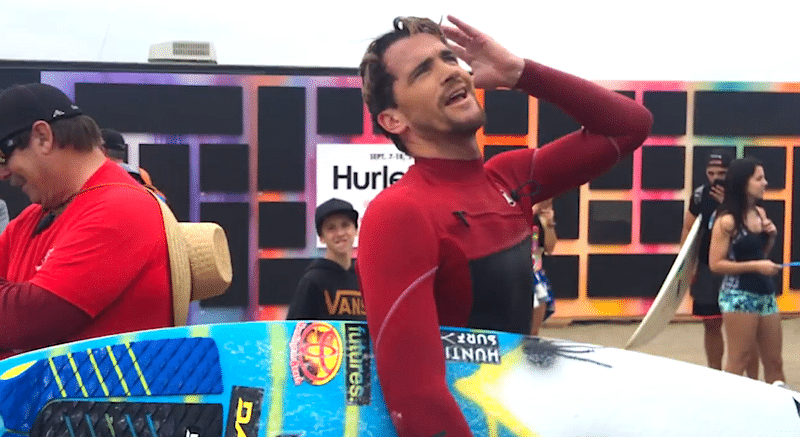Conversations with a surf junkie.
Ryan Burch has cut an innovative path through surfing. I can remember seeing his section in Psychic Migrations, sitting there at the premier in the multiplex in Fashion Island, which is about as Orange County as a girl can get. There’d been an accident on the 405, of course, and I got there late, too late to score a beer before the film started. I was in a bad mood, thanks to the traffic and the lack of beer.
Then I saw Burch, piloting his tiny, self-shaped 5’2” fish along beautiful green walls and my mood lifted. His surfing felt fresh. Suddenly, I was happy. I love how unpredictable he is – one day on a fish, then on a longboard, then riding a block of unglassed foam, because why the hell not.
“I can take anything I want that floats out into the ocean and you know, express myself on it,” he told me. That idea feels essential to surfing – whether you want to ride a fish or some sort of asymmetric invention or a clear-glassed thruster.
Earlier this spring, I called up Burch to talk about shaping. Here’s an excerpt from our conversation.
How did you get into shaping?
I started shaping belly boards [Paipos] . Also, wooden alaias after that. I could go to Home Depot and get some pieces of Douglas fir and sand on it and hit it with the tools just like a piece of foam. But I wouldn’t make a lot of mess and I was doing it on my mom’s patio, so that was pretty important to make it easy to clean up and non-toxic.
As soon as I got the opportunity to use a friend’s shaping bay. That’s when I shaped my first board, when I was 20, I used my friend’s Chris Cravey’s shaping bay and he taught me how to make a longboard. And then it was, I probably had more fun building the board than actually riding it. That’s what got me hooked.
Who has influenced your ideas about board design?
Yeah, for sure there are. The fish came from Steve Lis, so I’ve always kind of admired what he had done with it and kind of followed the principles that he had laid down a long time ago with the fish design. And then with shaping, I’ve learned a lot from Rich Pavel. He was a really good shaper and he really taught me a variety of different kinds of boards and different kinds of design theories. And so I think I learned the most from him as far as actually shaping surfboards.
There’s Carl Ekstrom with the asymmetrical thing and just free thinking and going outside the box. He’s always been a huge inspiration with that and making shaping seem like it’s not like within the parameters of the PU blank and traditional fiber glass. He really thinks of alternative ways to make a board.
And then a lot of guys who are more designers than shapers also inspire me. Like my friend Richard Kenvin, who does the Hydronamica thing. He’s been a huge inspiration to me — just knowing a certain type of board, and like, identifying it and having his theory on it and relating it to a skate, progressive style. So he’s been a big inspo.
Same with Joel Tudor, because he’s such a longboard aficionado or snob, whatever you may call it. He seems to know what the best stuff is. He always seems to give me a pretty open opinion about what he thinks of the last board I shaped.
How does your surfing influence your board designs?
They’re directly related. I feel like the different types of boards are like different genres. It’s like different genres of music and learning to play them all, you need to know what you’re getting into from the start. So the way I ride a longboard is different from the way I ride one of the asymmetric shortboards. But it’s all connected, because it’s all surfing. You’re still out there trying to time a wave and trying to predict what’s going to happen.
What are you riding most often right now?
My go-to at the moment is, I’ve been really excited about making these little twin fin, pickle-fin, asymmetric boards. I guess for good waves, they’re like my normal shortboards and step-ups. I’ve been honing in a design with those that I want to ride everywhere when the waves are really good.
And I also been making some more California-friendly twinfin fishes. Different variations of it, using different fin types. For more gutless waves, using more pivotal fins. And then for the better, faster waves, using the traditional keel fins. And then just noseriders for the average day at Cardiff where I live, those are my favorite boards to ride. There’s really no better feeling than getting to the nose except getting barreled.
Why do you like asymmetric boards?
Asymmetrics are just subtle little benefits. I feel like they’re just a more highly custom board. It’s something where you know what you like on your toes and you know what you like on your heel side or your back side. And you’re just trying to combine those. For me, it’s just, a more tuned-in to the conditions you’re going to ride and your stance. It’s just more highly custom.
I’m still trying to keep the boards balanced and make them feel pretty fundamentally sound, but the little tweaks are there to help under your toes with what your toes can handle and under your heels with what they’re good at. Your toes kind of feather in their pressure, so the toe side will quicker and less forgiving.
If you could surf anywhere, where would you go?
I would probably go to Tavarua and go surf Cloudbreak. I think that would anyone’s idea of paradise. I just feel like it’s just a really good wave for the boards and the way I like to surf. It just has a long wall and it goes really fast. It just really matches the speed of my boards. It’s just an unbelievable wave that you can get barreled on, but still turn. And you know, feel really, really fast.
So the theme here is that you like to go really fast and you like to design boards that make you go fast.
That’s pretty much the underlying theme here. If you have enough speed you can do anything. Once you have speed you can do anything — it’s just a lot more fun.
What haven’t you accomplished yet that you’d like to?
I’d really like to experiment with materials a little bit more. I’d like to make some nice wooden boards, too, just kind of get deeper into the craftsman side of the thing. I’d like to build some beautiful wooden boards. And maybe even take it to small sailboat-sized boards. Make them bigger and make them more beautiful.







